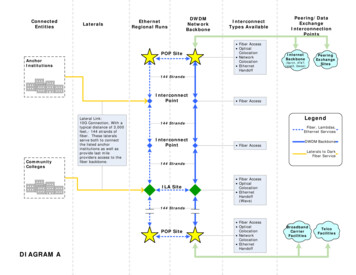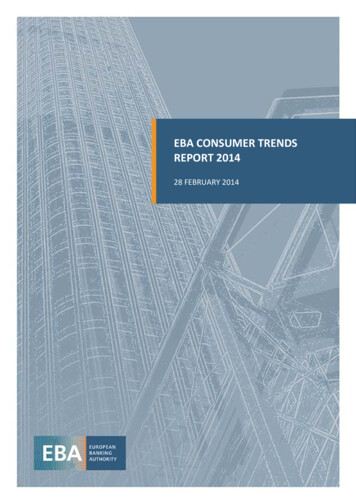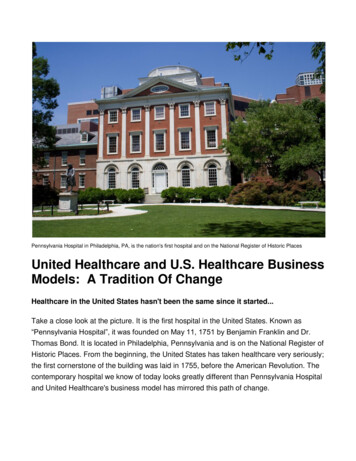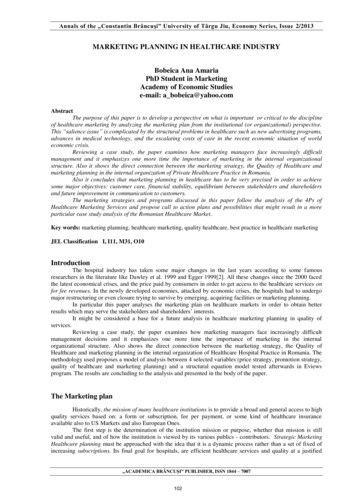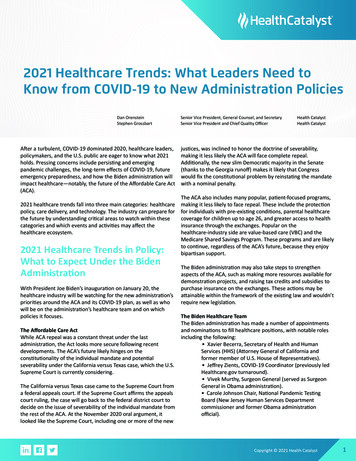
Transcription
2021 Healthcare Trends: What Leaders Need toKnow from COVID-19 to New Administration PoliciesDan OrensteinStephen GrossbartAfter a turbulent, COVID-19 dominated 2020, healthcare leaders,policymakers, and the U.S. public are eager to know what 2021holds. Pressing concerns include persisting and emergingpandemic challenges, the long-term effects of COVID-19, futureemergency preparedness, and how the Biden administration willimpact healthcare—notably, the future of the Affordable Care Act(ACA).2021 healthcare trends fall into three main categories: healthcarepolicy, care delivery, and technology. The industry can prepare forthe future by understanding critical areas to watch within thesecategories and which events and activities may affect thehealthcare ecosystem.2021 Healthcare Trends in Policy:What to Expect Under the BidenAdministrationWith President Joe Biden’s inauguration on January 20, thehealthcare industry will be watching for the new administration’spriorities around the ACA and its COVID-19 plan, as well as whowill be on the administration’s healthcare team and on whichpolicies it focuses.Senior Vice President, General Counsel, and SecretarySenior Vice President and Chief Quality OfficerHealth CatalystHealth Catalystjustices, was inclined to honor the doctrine of severability,making it less likely the ACA will face complete repeal.Additionally, the new slim Democratic majority in the Senate(thanks to the Georgia runoff) makes it likely that Congresswould fix the constitutional problem by reinstating the mandatewith a nominal penalty.The ACA also includes many popular, patient-focused programs,making it less likely to face repeal. These include the protectionfor individuals with pre-existing conditions, parental healthcarecoverage for children up to age 26, and greater access to healthinsurance through the exchanges. Popular on thehealthcare-industry side are value-based care (VBC) and theMedicare Shared Savings Program. These programs and are likelyto continue, regardless of the ACA’s future, because they enjoybipartisan support.The Biden administration may also take steps to strengthenaspects of the ACA, such as making more resources available fordemonstration projects, and raising tax credits and subsidies topurchase insurance on the exchanges. These actions may beattainable within the framework of the existing law and wouldn’trequire new legislation.The Biden Healthcare TeamThe Biden administration has made a number of appointmentsand nominations to fill healthcare positions, with notable rolesThe Affordable Care Actincluding the following:While ACA repeal was a constant threat under the last Xavier Becerra, Secretary of Health and Humanadministration, the Act looks more secure following recentServices (HHS) (Attorney General of California anddevelopments. The ACA’s future likely hinges on theformer member of U.S. House of Representatives).constitutionality of the individual mandate and potential Jeffrey Zients, COVID-19 Coordinator (previously ledseverability under the California versus Texas case, which the U.S.Healthcare.gov turnaround).Supreme Court is currently considering. Vivek Murthy, Surgeon General (served as SurgeonGeneral in Obama administration).The California versus Texas case came to the Supreme Court from Carole Johnson Chair, National Pandemic Testinga federal appeals court. If the Supreme Court affirms the appealsBoard (New Jersey Human Services Departmentcourt ruling, the case will go back to the federal district court tocommissioner and former Obama administrationdecide on the issue of severability of the individual mandate fromofficial).the rest of the ACA. At the November 2020 oral argument, itlooked like the Supreme Court, including one or more of the newCopyright 2021 Health Catalyst1
Cyrus Shahpar, COVID-19 Data Director (CDC official, and FEMA official in Obama administration). Anthony Fauci, Director of the National Institute of Allergies and Infectious Diseases (the current Director of the NationalInstitute of Allergies and Infectious Diseases, will remain in his post and serve as Biden’s Chief Medical Advisor). Sonya Bernstein, Senior Policy Advisor (HHS official). David Kessler, Chief Scientific Advisor to Operation Warp Speed (former FDA Commissioner). Rochelle Walensky, Director of the CDC (Chief of Infectious Diseases at Massachusetts General Hospital and Professor atHarvard Medical School). General Gustave Perna, Operation Warp Speed COO (to continue to control vaccine distribution logistics). Marcella Nunez-Smith, COVID-19 Equity Task Force Chair (a new role) (Professor at the Yale School of Medicine and theFounding Director of Yale’s Equity Research and Innovation Center). Osaremen Okolo, Policy Advisor (Senior Health Policy Advisor to U.S. Representative Jan Schakowsky of Illinois). Andrea Palm, Deputy Secretary HHS (Wisconsin health official and former Obama administration official).These appointments and nominations point to a strong emphasis on COVID-19 recovery and vaccine distribution and coordination.For example, Fauci remains as the Director of the National Institute of Allergies and Infectious Diseases, and there’s now a COVID-19data director (Shahpar), indicating this administration will emphasize data and reporting. Also evident in these appointments is aBiden administration focus on health equity and healthcare disparities—particularly with Nunez-Smith as the first Equity Task ForceChair for COVID-19.Democratic control in the Senate will also impact healthcare. For example, Washington state Senator Patty Murray will chair theSenate Committee on Health, Education, Labor, and Pensions. She has advocated for a more robust federal response on COVID-19.And Senator Ron Wyden, Oregon, leads the Finance Committee and has pushed for drug pricing reform and drug price negotiation.Biden Administration PrioritiesCOVID-19 tops the Biden administration’s priorities and will likely do so for the foreseeable future. Vaccine distribution will dominatethe first six months of 2021, with federal effort focused on the expansion of testing, contact tracing, and better public healthreporting from states and localities up to the CDC and other federal agencies.Data collection and expanded use of data will be critical to the Biden administration’s ongoing COVID-19 response. Theadministration proposes funding to states and localities for their public health response infrastructure (including registries, reporting,surveillance, and dashboards). The administration also plans to expand the availability of platforms that ensure patient data securityand to expand data use rights to enable use and disclosure for research and surveillance. These actions will accelerate research oneffective clinical interventions and treatment pathways, expand patient monitoring, and help public health reporting and trackingvaccine distribution.The new administration will also likely push to expand healthcare program funding, including ACA programs and value-based care,and expansion of coverage. The Senate may use the budget reconciliation process to push through a COVID-19 relief package andsome healthcare-related policies. Budget reconciliation requires only a majority vote, as contrasted to a supermajority vote forregular legislation. However, budget reconciliation can only happen a couple of times per year, generally speaking, when the budgetis up for approval, and is limited to budget-related items.Budget reconciliation pushed through some provisions of the ACA in 2010. While some of the ACA expansions, increased subsidies,and tax credits could occur through budget reconciliation, this process would not be available for bigger picture health policy issuesthat are unrelated to the federal budget. These bigger picture items include issues such as a public option, Medicare for all, andlowering the Medicare eligibility age to 60.The following policy priorities, if the administration adopts them, would also help the nation better prepare for future emergencies atthe health system, local, state, and national levels: A national patient matching strategy, such as implementing a national patient identifier, will be critical in public healthemergencies to enable healthcare organizations to link patients across providers and health information exchanges andsurveillance and contact tracing efforts. Continued support for interoperability across the healthcare industry and enforcement against information blockingpractices will also enhance emergency preparedness. Funding for the development of a national epidemic/pandemic information network that will include an overhaul oftheCDC’s data aggregation and reporting system, and mandating healthcare data vocabulary standards across EHRs.Copyright 2021 Health Catalyst2
vThe Biden Administration COVID-19 PlanThe Biden administration has released its National Strategy for the COVID-19 Response and Pandemic Preparedness, a 1.9trillion-dollar plan, which Congress was debating as of early February 2021. Although Congress will likely approve a reducedCOVID-19 relief package, some notable features of the proposal include the following: A national vaccination program, including 20 billion to states, localities, tribes, and territories to launch communityvaccine centers around the country and mobile vaccination units. Enhanced testing and contact tracing, including 50 billion to expand testing, including in-home and instant tests, andfunding the hiring of 100,000 public health workers to assist in vaccine distribution and build public health capacity. Equitable distribution of tests, treatments, and vaccines, including addressing disparities in the equitable distribution ofvaccines and supplies and expanded services and vaccine availability for underserved populations. Domestic production of personal protective equipment (PPE), including fully utilizing the Defense Production Act toincrease the production of masks, face shields, and other PPE, a 30 billion investment in the Disaster Relief Fund, and 10billion to expand manufacturing capacity. Support Tribal governments’ response to COVID-19, including a 20 billion investment and access to PPE, clean water,electricity, and internet for education, telehealth access, and more. Public health surveillance, including expanded surveillance of new strains of COVID-19 and monitoring effectiveness ofnew treatments and therapies. Support for first responders and essential workers, including 350 billion in emergency funding to state, local, andterritorial governments to ensure support of frontline workers (e.g., in healthcare, education, and vital services). Preserve and expand healthcare coverage, including subsidizing COBRA continuation through the end of September 2021and expanding and increasing the Premium Tax Credit.2021 Healthcare Trends in DeliveryLike healthcare policy, COVID-19 will continue to drive care delivery in 2021. The pandemic will shape healthcare moving forward,with the impact and toll of the virus factoring in care delivery for a long time. Critical areas of concern include how COVID-19continues to impact health systems, clinicians, providers, patients, and VBC programs and healthcare delivery changes to prepare forfuture pandemics.The Toll of COVID-19As of early February 2021, the Washington Post reported that COVID-19 deaths had reached over 2 million worldwide. This numberincluded more than 444,00 deaths in the United States and more than 100 million cases worldwide.In Figure 1, below, from Center for Disease Control (CDC), the bottom line shows the expected deaths in the United States for anygiven year. As of January 23, 2021, the actual observed numbers of deaths were well above the threshold for excess deaths.Figure 1: U.S. COVID-19 deaths likely exceed threshold rates.The above numbers represent a tremendous burden on COVID-19 victims and their loved ones and the U.S. healthcareworkforce—with both physical and mental impacts. Those working in high-risk departments (e.g., emergency departments (EDs) andICUs) with infected patients, sometimes with suboptimal PPE access, have felt the most significant impact and experienced thehighest mortality. This loss will impact the industry indefinitely. To fill in frontline gaps, many organization team members who usuallyfocus on process improvements in care settings are doing frontline work. This matter reflects the financial impact and the shortage ofstaff due to COVID-19.Copyright 2021 Health Catalyst3
The CDC has responded to the pandemic’s toll with Project Firstline, an initiative for communities and health frontline workers topromote infection prevention and infection control. The Health Research and Education Trust, American Medical Association, and theAmerican Nurses Association co-sponsor the initiative, which provides practical tools and resources to implement infection controlprotocols in every patient interaction.COVID-19-Driven Changes to Care DeliveryThe influx of COVID-19 patients has driven massive change in the healthcare delivery system. According to the Kaufmann HallNational Hospital Flash Report, many individuals are avoiding routine and elective interactions with healthcare, with consequencesincluding a drop in weekly screening for breast cancer, colon cancer, and cervical cancer of between 86 and 94 percent, according tothe Kaufmann Hall National Hospital Flash Report: December 2020. Foregoing screenings and other preventive care will have along-term impact on healthcare, as early detection and intervention will decrease.Kaufmann Hall’s findings also showed discharges volumes were down in terms of elective discharges, as were operating roomminutes, elective procedures and ED visits in general, and revenues were dramatically down at 14 percent per adjusted discharge.Outpatient revenue (a source of loss for elective work) was down 6 percent compared to an inpatient revenue drop of 1 percent.As healthcare consumers have made fewer routine and elective visits, organizations have felt a financial impact, hitting ambulatoryand hospital settings. Operating margins have fallen dramatically, with a 5 percent drop in margins nationwide by the end of 2020.The CARES Act provider relief has given some support to the healthcare delivery system, but 2020 margins still declined nearly 2%compared to 2019 (Figure 2, Kaufman Hall National Flash Report: December 2020).Figure 2: Even with the CARES Act, hospital operating margins fell dramatically in 2020.A Light at the End of the Tunnel but More Challenges to Come: The COVID-19 VaccineIn 2021, on the other side of COVID-19’s tolls, is a light at the end of the tunnel: the COVID-19 vaccine. By the last week of January,the United States averaged around 1.5 million vaccinations a day.Despite encouraging vaccination numbers, distribution is meeting challenges. According to the Kaiser Family Foundation, someAmericans are hesitant to receive the vaccine, a preference that appears to correspond to political orientation, ethnicity, age, andurban or rural setting (Figure 3, Kaiser Family Foundation).Figure 3: COVID-19 vaccine hesitancy in the United States.Copyright 2021 Health Catalyst4
As of December 2020, people in their 50s and older, urban residents, those with a household member with a health condition,Democrats, and Hispanic adults appeared more likely to get the vaccine, and women were more likely than men. Interestingly,healthcare workers were a little cautious, with 29 percent hesitancy.One of the best chances for more comprehensive COVID-19 vaccination among U.S. populations is for primary care physicians tobecome a recognized information source about the vaccine. According to a Kaiser Family Foundation poll, 85 percent of patientsregard their healthcare provider as the most trusted source of information about the vaccine.2021 Healthcare Trends in TechnologyAs an extension of COVID-19’s far-reaching impact across healthcare, the pandemic has also affected healthcare technology,accelerating some changes and dramatically demonstrating how nimble the industry can be. Healthcare data analytics, artificialintelligence, and telemedicine capabilities have massively expanded to support the pandemic response and recovery, a trend thatwill likely continue to propel healthcare technology.Data and Analytics Are Increasingly Central to Health System OperationsCOVID-19 made the need to leverage data and advanced analytics central to many health systems. Expansion of those capabilities tomeet the demand for real-time data or close to real-time data has been dramatic.For example, hospital administrators are looking at their COVID-19 dashboards hourly and using data to update their businessintelligence reporting tools. Previously, the most useful artificial intelligence applications (AI) and machine learning (ML) were likelypredicting revenue cycle trends, with attempts for more sophisticated use, such as reading imaging with AI stalled. Now, COVID-19has compelled innovation to bring advanced analytics to the forefront of disease response, using predictive models to track the virusand estimate the risk of COVID-19 to patients with severe symptoms, enabling more effective treatment.Health systems are rapidly expanding their support for a digital workforce, including the chief information officer (CIO) role. The CIOis playing a larger role in an organization’s strategy, risk management, and cybersecurity. The EHR has expanded and will likelycontinue to evolve with digital and voice assistance and natural language processing. With such clinical IT developments, includingaugmented reliable and wearable technology so that patients can make decisions in real-time with real data, the digital workforceand CIO roles stand to continue to grow.Telehealth Is Here to StayCOVID-19 created an urgent need for telehealth to care for patients outside of the clinic or office setting and offset financial lossesdue to reduced ambulatory visits. According to a McKinsey study, the number of patients using telehealth increased from 11 to 46percent in 2020, with growth likely to continue. McKinsey predicts telehealth could account for 20 percent, or 250 billion, of U.S.healthcare spending in the near future.Though the transition towards expanded telehealth is in motion (including policy changes around accessibility and reimbursement),healthcare technology will still need to adapt to accommodate the continuing shift. Health systems need greater integration withexisting technology platforms and strategies to address cybersecurity and privacy concerns. In this way, telehealth is another areathat will increase demands on the digital workforce and healthcare CIOs.Through Loss and Recovery, a Silver LiningThe healthcare industry begins 2021 forever-changed by COVID-19 and still trying to recover and find its direction. While healthcareleaders and professionals are recuperating from the significant losses of 2020, they will continue to face challenges as the pandemiccontinues and the recovery begins. A new federal administration will look to lessons learned so far during the pandemic, availabledata, and industry experts, to accelerate vaccine distribution and get the nation back on its feet. Changes in care delivery models andtechnology have accelerated, and will continue to, as a result of the pandemic response and recovery. Perhaps a silver lining is thatthe healthcare industry, patients, and providers, would continue to benefit from these positive developments in care delivery andtechnology.Copyright 2021 Health Catalyst5
About the AuthorsPrior to joining Health Catalyst Dan Orenstein was at athenahealth, Inc. (NASDAQ: ATHN) for 10 years,the last 7 as General Counsel and Secretary. Prior to that, Dan practiced in the areas of corporate,intellectual property, and healthcare law with law firms in Boston and Washington, D.C. He has writtenand presented on health care law and IT topics throughout his career. He also served as a leader of theAmerican Health Lawyers Association’s Health IT practice group.Stephen R. Grossbart, PhD, is an experienced health care executive with experience as a senior vicepresident and chief quality officer and chief analytics officer at Mercy Health, Cincinnati Ohio, where heoversaw Mercy’s Center for Patient Safety and Clinical Transformation. His published work has appearedin Medical Care Research and Review, American Journal of Health-System Pharmacy, Journal of Healthcare Management and Archives of Surgery. In 2012, his book chapter, “Conceptualization and Definitionsof Quality,” appeared in Health Care Quality: The Clinician's Primer edited by David Nash, MD, MBA. Hehas served and co-chaired on multiple National Quality Forum committees, dating back to 2003. In 2013,he was named as one of the 50 Experts Leading the Field of Patient Safety by Becker’s Hospital Review.Copyright 2021 Health Catalyst6
2021 healthcare trends fall into three main categories: healthcare policy, care delivery, and technology. The industry can prepare for the future by understanding critical areas to watch within these categories and which events and activities may affect the healthcare ecosystem. 2021 Healthcare Trends in Policy: What to Expect Under the Biden

